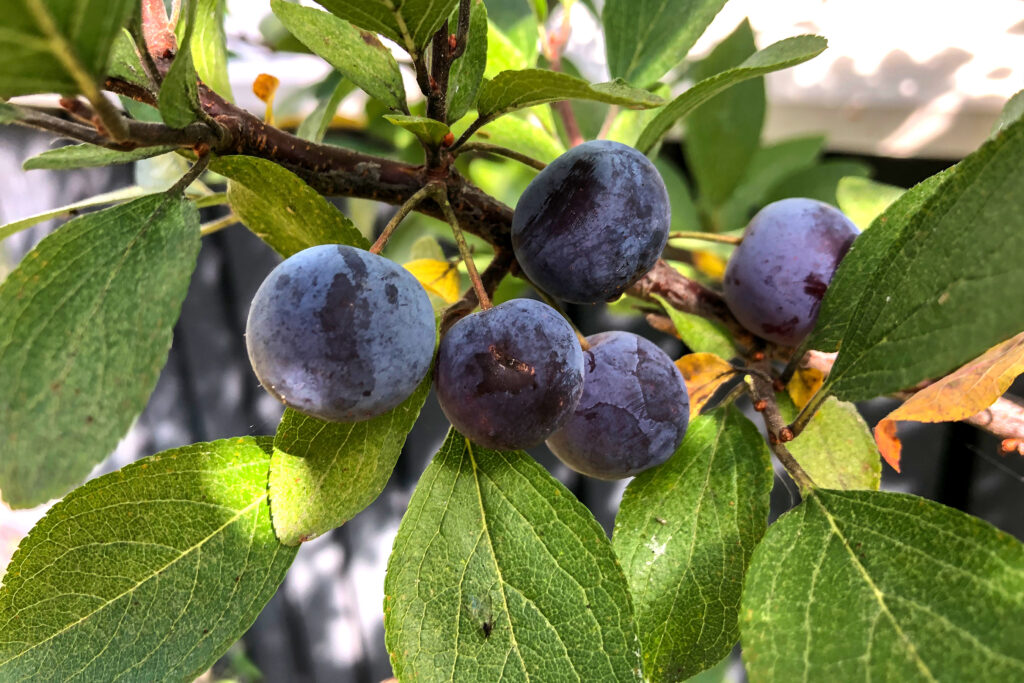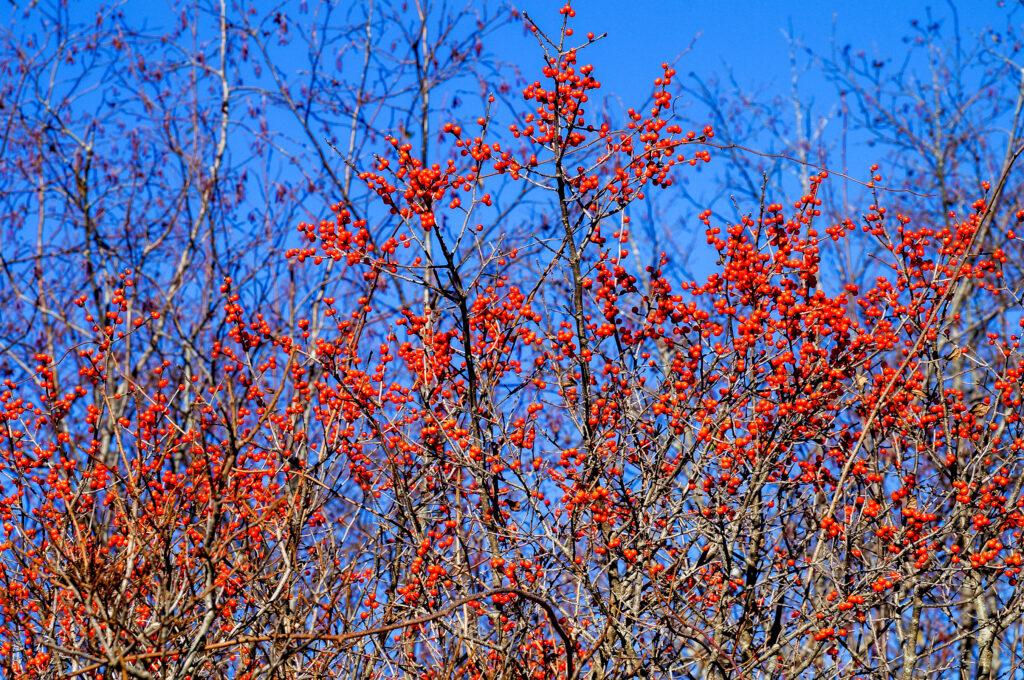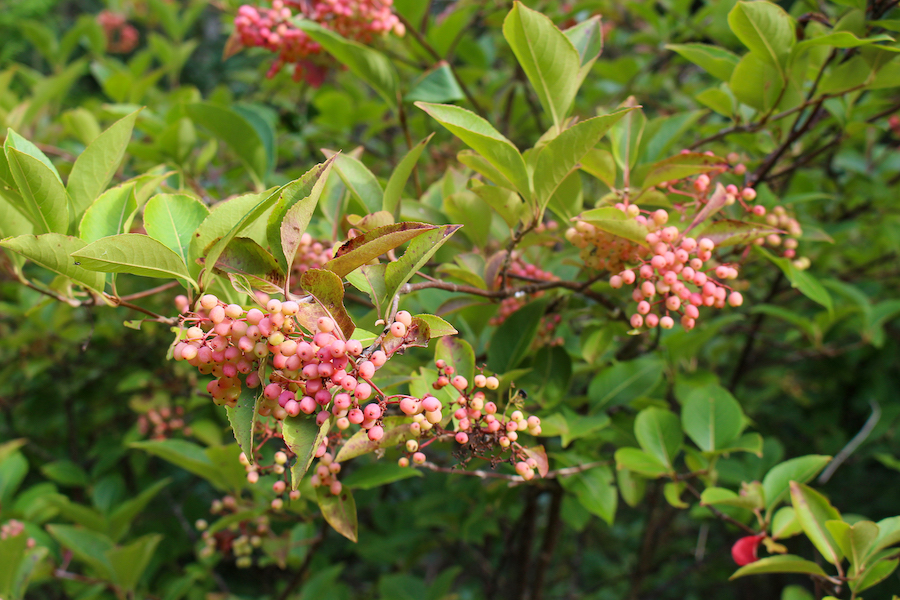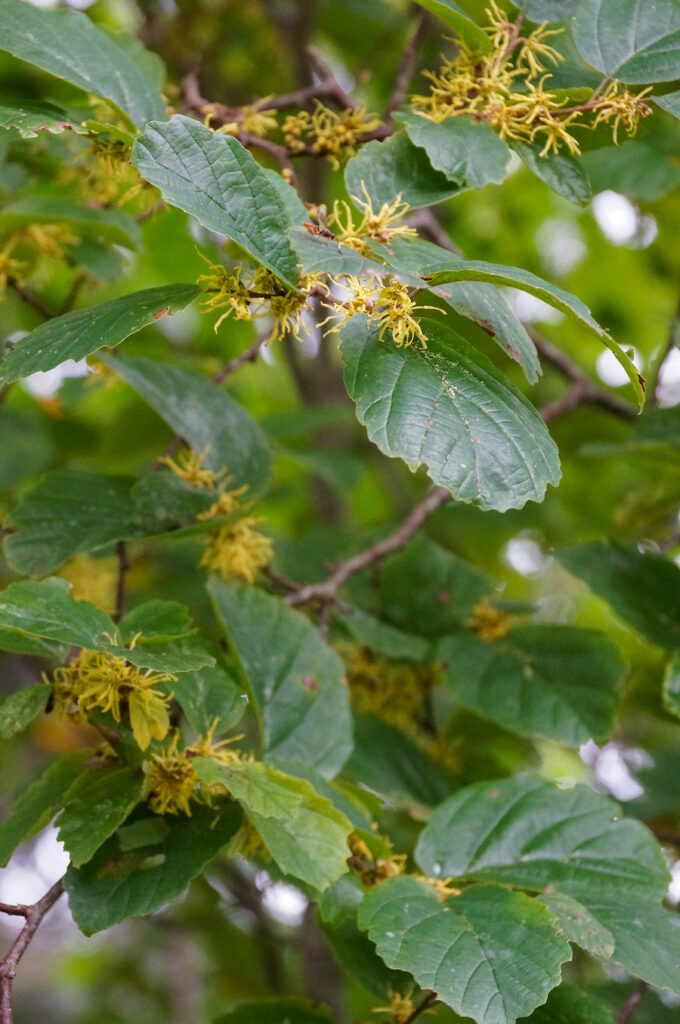By Heather McCargo
A hedgerow planted with native species of trees, shrubs and groundcovers enhances a farm with year-round habitat for pollinating insects, birds and the many other creatures and processes critical for our regional ecosystems to function. Our agricultural landscapes once had many hedgerows and edges where native species persisted — all the places the farmer did not have the time or machinery to manage and where the family turned to for foraging edible plants. Of course, before colonists arrived, our native habitats were sustained through the millennia by Indigenous people who relied on these ecosystems for all of their needs. But in the past half century many of these remnant patches have disappeared, and now we are in a situation where we need to deliberately restore native habitat since populations of our indigenous plants and animals are declining, even in our rural state of Maine.

This might seem to be some nostalgic attempt to return to past farming landscapes, but it is not; hedgerows are an important path to restoring healthy wild processes (i.e., ecosystem services) to all of our landscapes. This is called “rewilding” and is a deliberate shift from human-centered, intensively managed landscapes to humans sharing landscapes with the rest of nature. This rewilding process begins with adding more native plants as they are the foundation of all of our terrestrial ecosystems. Rewilding envisions a resilient future with the needs of humans, including our agricultural crops, in balance with the wild ecosystems that support all of life. Hedgerows are an important way to do this on a farm that is also dedicated to cultivate crops and animals needed to feed the more than seven billion humans living on our small planet.
What Does a Hedgerow Look Like?
A hedgerow is a diverse planting of woody plants — from shrubs to small trees along with herbaceous groundcovers at their base — grouped together with similar demands of soil type, moisture and sunlight. Think layers of vegetation: an occasional large tree rising up above a mixture of shrubs, some of considerable width, others with tall, arching stems under-planted with lower shrubs, so that every available space is covered in growth. Multiples of each species are normally planted to insure healthy cross-pollination and to provide an abundance of food for pollinators and birds. As the hedgerow matures it can provide a tremendous amount of habitat that leaves little space for opportunistic weeds to grow.
A hedgerow should be a minimum of 6 feet wide, with 15 feet as the ideal. Connecting the hedgerow to other vegetation, such as woodlands, meadows, wetland, existing yard trees and neighboring landscapes, will link disconnected habitats and assist plants, pollinators and birds in their movement. The larger the hedgerow, the greater the benefits. You can start small and extend your hedgerow a bit every year.
A hedgerow can be planted as a buffer along a road, as a divider between fields, on the shady edge of the forest, in low, wet areas such as in a swale or ditch (an area too wet to plant with traditional crops and often drained in agricultural systems), or in those dry, rocky or sandy areas where annual crops cannot thrive. This can include those in-between places where you now mow, or where the soil type does not support cultivated crops. There are native species that thrive in every type of growing condition — from the wet to the dry and even in deep shade. There is no need to give up your fertile fields; this is an opportunity to bring more life to those areas less desirable for your crops.
Benefits of a Native Hedgerow to a Farm
Native plants are invaluable additions to a farm landscape because of the many ecosystem services they provide, including:
- Native plants provide food and habitat for birds that are critical for maintaining a healthy balance of insect populations.
- Native plants provide year-round food and habitat for pollinators, who need more than summer flowers for foraging. Insects also need the leaves, bark, branches, dried stems and leaf litter that perennial woody and herbaceous native plants provide throughout the year for nesting and protection from predators.
- Native trees, shrubs and herbaceous perennials have deep roots that create a permanent diverse soil community of fungi, small critters and microorganisms different from a regenerative organic farm soil where digging and harvesting disrupts many species in the soil.
- Many hedgerow plants have a harvestable crop of flowers, fruits or nuts, or branches for winter decorations and providing additional farm income.
Native Hedgerows are Low-Maintenance Plantings
Native species are much less demanding in their care and nutrient needs compared to domesticated crops. I am an experienced vegetable and herb gardener, and I really appreciate how much hard work it takes to nurture our agricultural crops. I know that farms need more low-maintenance plantings — which many native plants are when they are matched to the site conditions.

Native wild plants do not have the high nutrient demands of cultivated crops. With a native habitat planting, soil fertility is maintained with the annual fall of leaves and other woody debris, plus the droppings of birds and other creatures that make the hedgerow their home. The fungi and soil microorganisms break down this annual recycling of nutrients and slowly release it to the hedgerow plants. No yearly additions of composts, manures or mulches are needed — these can be saved for the domesticated farm crops.
Preparing Your Site
Now I am going to walk you through the steps to create hedgerows in a variety of different growing conditions, pointing you to the best species to plant and where to find native plants.
I prefer the smothering method of sheet mulching. It is the easiest and best way to prepare the site that has been mowed meadow or lawn. If the area has some existing native trees and shrubs, all the better as the sheet mulch won’t damage them. You need to do this for at least 3 to 12 months before planting to give the smothered vegetation time to break down and return to the soil.
These are the steps:
1. Mow existing vegetation low to the ground.
2. Lay down overlapping layers of cardboard (the bigger the better) to cover the whole area to be planted.
3. Add a thick layer of mulch — at least 3 inches, making sure the cardboard is well covered.
4. Mulch can be leaves (best), wood chips (aged is better), a very thick layer of straw or spoiled hay, or bark mulch for a neater look.
5. Wait 3 to 12 months to let the cardboard and mulch do its job of killing the existing vegetation.
6. Choose your plants while you wait.
The two best times to plant are early spring (as soon as the ground thaws before mid-May) or in the fall (September or October). You can slice right through the mulch when it is time to plant.
If you intend to make your hedgerow in an area with invasive woody shrubs, such as buckthorn, honeysuckle, burning bush or barberry, these need to be removed first, either individually (try a weed wrench or enlist some energetic youth), or if you have animals, fenced goats and pigs are very effective at removing woody vegetation. For more information, check out Wild Seed, volumes 5 and 6, for articles on removing invasive species with goats and other mechanical methods without chemicals.
Choosing and Finding Native Plants
To choose plants that will thrive on your site, you must first assess your soil type, moisture level and sun exposure. Once you have done this, you can look at the lists below and choose your native plant species to match your specific growing conditions. In your hedgerow, plan to use at least a dozen different species with multiples of each kind.
Bare root trees and shrubs establish very well when planted in early spring. Plugs — small first- year plants — establish successfully when planted in both the spring and the fall. Wild Seed Project’s website has a page dedicated to helping you find regional sources of native plants. Wild Seed Project also has lots of resources on how to grow native plants from seed yourself.
Plants for Sunny Medium Soils
For a mostly sunny site with mesic soil (medium moisture and fertility, moist in spring, may be dry in the summer):

- Shadbush (Amelanchier spp.), multi-stemmed small tree
- Chokeberry (Aronia spp.), multi-stemmed medium shrub
- Wild plum (Prunus americana and wild cherry species), suckering small tree
- Hawthorne (Crataegus spp.), small tree
- Hazelnut (Corylus americana), multi-stemmed medium shrub
- Redbud (Cercis canadensis), small tree
- Bottlebrush buckeye (Aesculus parviflora), suckering large shrub
- Yellow bush honeysuckle (Diervilla lonicera), suckering low shrub
- Shrubby St. John’s-wort (Hypericum prolificum), small shrub
- Quaking aspen (Populus tremuloides), medium-sized colonizing tree
- Wild rose (Rosa virginiana), suckering low to medium shrub
- Shrub dogwood (Swida racemosa, S. sericea), suckering large shrub
- Meadowsweet (Spiraea alba, S. tomentosa), small shrub
- Arborvitae (Thuja occidentalis), medium-sized evergreen tree
- Sassafras (Sassafras albidum), medium-sized colonizing tree
- Viburnum (Viburnum americanum, V. lentago, V. nudum, V. dentatum), arching multi-stemmed large shrubs
- New England aster (Symphyotrichum novae-angliae), herbaceous groundcover
- Canada anemone (Anemone canadensis), colonizing herbaceous groundcover
- Milkweed (Asclepias syriaca), colonizing herbaceous groundcover
- Mountain mint (Pycnanthemum virginicum), colonizing herbaceous groundcover
Plants for Wet Soils, Mostly Sunny
- Pussy willow (Salix discolor), multi-stemmed large shrub*
- Sweetgale (Myrica gale), multi-stemmed low evergreen shrub
- Elderberry (Sambucus nigra ssp. canadensis), multi-stemmed suckering large shrub*
- Inkberry (Ilex glabra), suckering medium evergreen shrub*
- Silky dogwood (Swida amomum), suckering large shrub
- Summersweet (Clethra alnifolia), suckering medium shrub*
- Buttonbush (Cephalanthus occidentalis), suckering medium shrub
- Winterberry holly (Ilex verticillata), multi-stemmed medium shrub*
- Golden groundsel (Packer aurea), colonizing herbaceous groundcover
- Golden alexanders (Zizia aurea), herbaceous groundcover
- New York aster (Symphyotrichum novi-belgii), colonizing herbaceous groundcover
- Swamp milkweed (Asclepias incarnata), herbaceous groundcover
- Ferns (Osmunda spp.), colonizing herbaceous groundcover
*Note: these species are also tolerant of medium moisture soils.
Plants for Sunny Dry Sandy or Gravelly Soil
- Chokeberry (Aronia melanocarpa), low suckering shrub
- Dwarf shadbush (Amelanchier spicata), low suckering shrub
- Sweet-fern (Comptonia peregrina), low suckering shrub
- New Jersey tea (Ceanothus americanus), low shrub
- Shrubby St. Johnswort (Hypericum prolificum), low shrub
- Lowbush blueberry (Vaccinium angustifolium), low suckering shrub
- Bayberry (Morella caroliniensis), medium suckering shrub
- Beach plum (Prunus maritima), small tree or large colonizing shrub
- Bear oak (Quercus ilicifolia), small bushy tree
- Dwarf chinkapin oak (Quercus prinoides), small tree
- Pitch pine (Pinus rigida), medium evergreen tree
- Gray birch (Betula populifolia), medium multi-stemmed tree
- Eastern red cedar (Juniperus virginiana), medium evergreen tree
- Sumac (Rhus spp.), large colonizing shrub
- Wild rose (Rosa virginiana), low to medium suckering shrub
- Pussytoes (Antennaria spp.), herbaceous colonizing groundcover
- Wild strawberry (Fragaria virginiana), herbaceous colonizing groundcover
- Northeastern beardtongue (Penstemon hirsutus), herbaceous groundcover
Add a Few Large Canopy Trees

Consider incorporating the occasional large canopy tree into these sunny hedgerows. Oaks are easy to grow from an acorn planted in the mulch — swamp white oak for wet areas, red oak for medium soils, or bur oak medium to dry soils.
Hedgerow Plants for Shady Sites
For part to full shady areas such as under-tree canopies or along the north or east side of a building, here are some recommended plants:
- Striped maple (Acer pensylvanicum), medium-sized tree
- Mountain maple (Acer spicatum), multi-stemmed large arching shrub
- Shadbush (Amelanchier canadensis, A. laevis), multi-stemmed small tree**
- Pawpaw (Asimina triloba), colonizing medium tree
- Hazelnut (Corylus americana), multi-stemmed medium shrub**
- Yellow bush honeysuckle (Diervilla lonicera), suckering low shrub**
- Witch hazel (Hamamelis virginiana), multi-stemmed large shrub or tree
- Smooth hydrangea (Hydrangea arborescens), multi-stemmed medium shrub**
- Spicebush (Lindera benzoin), multi-stemmed large shrub
- Purple-flowering raspberry (Rubus odoratus), suckering medium shrub **
- Red elderberry (Sambucus racemosa), medium shrub
- Ironwood (Carpinus caroliniana), multi-stemmed small tree**
- Hophornbeam (Ostrya virginiana), single-stemmed medium tree**
- Pagoda dogwood (Swida alternifolia), single- or multi-stemmed small tree
- Azalea (Rhododendron prunifolium, R. viscosum), medium shrub
- Maple-leaved viburnum (Viburnum acerifolium), low suckering shrub
- Lowbush blueberry (Vaccinium angustifolium), very low suckering shrub**
- Hobblebush (Viburnum lantanoides), multi-stemmed medium shrub
- Wood aster (Eurybia divaricata, E. macrophylla), colonizing herbaceous groundcover
- Zigzag goldenrod (Solidago flexicaulis), colonizing herbaceous groundcover
- New York fern (Thelypteris noveboracensis), herbaceous groundcover
- Ostrich fern (Matteuccia strethiopteris ), herbaceous groundcover
- Maidenhair fern (Adiantum pedatum), herbaceous groundcover
**These species also grow well in full sun.
Let’s All Take Action
Whether you start small or large, a hedgerow will expand habitat on your farm, create corridors for wildlife, improve your farm’s ability to capture and store rainwater and carbon, and add some beauty. Imagine if all our landscapes — from the rural farms stretching into the urban areas — were connected via a network of hedgerows. This linking of habitats would be a huge boost to plant and animal diversity. It would also provide ecosystem resiliency, and enable fauna and flora populations to migrate with our warming climate.
Further Resources
The Wild Seed Project website is filled with many free resources, including a downloadable list of bloom times of native plants, and numerous blog on topics such as groundcovers, canopy trees, vines, seed sowing, and more. Visit wildseedproject.net for more information.
Heather McCargo is the founder of Wild Seed Project, a Maine based 501(c)3 nonprofit that works to increase the use of seed grown native plants in all landscape settings. Wild Seed Project sells seeds of locally grown wild type native plants, publishes native plant guides and educates the public so that a wide range of people can participate in increasing native plant populations.
